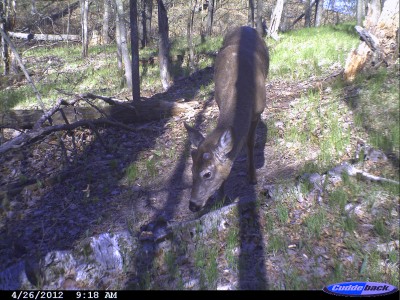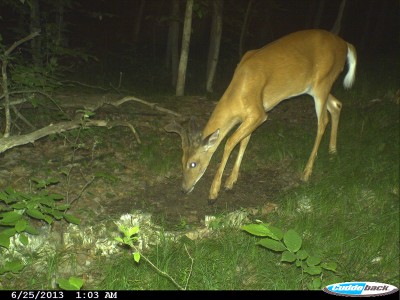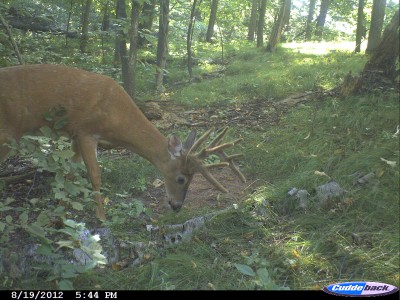Those Amazing Antlers
Bernie Barringer 05.02.14

Nonhunters often have a difficult time understanding a hunter’s fascination with antlers. What it is about a piece of bone that creates such a passion in outdoorsmen and women? I believe that the fascinating phenomenon that causes antlers to grow, drop, and regrow each year is a process that draws us in because it is unique and amazing. Antler growth is the fastest form of mammal tissue growth known to man; antlers can grow up to an inch a day. No other animal outside the members of the deer family can boast of this remarkable annual event.
Antlers are not horns. Horns are not shed and regrown each year—they have a core of living tissue and grow from the inside out. Horns are composed primarily of keratin, the same substance that makes up hair and fingernails. Antlers are made of solid bone, consisting mostly of calcium and phosphorous. Let’s take a look at the annual cycle of antlers.
Click here to learn about whitetail antlers in infographic format.

The annual cycle is entirely controlled by photoperiodism, which means that it is a physiological process governed by the length of day or night. In early spring, the bucks are without antlers, but when the pituitary gland is stimulated by the longer daylight hours later in the season, the antlers begin to grow. Growth usually begins in mid-April.
As they grow, the antlers are covered with a soft substance called velvet because of its felt-like nature. The velvet carries blood and is warm to the touch. It is also sensitive, so bucks often seek out secluded areas while their antlers are growing. If they bump into anything with their new antler growth, they feel it! This is how bucks learn what they have on their heads as the summer progresses.
As the growing antlers fork and create the shape they will carry with them through the year, they are susceptible to injury. They could partially break a tine or a beam and that beam will continue to grow in the direction it is pointed after breaking. In some cases, these broken tines have grown into eyes or jaws and either blinded or even killed deer. This is not to be confused with sticker points and other “nontypical” points, which are caused by genetics.
The number of points is not closely connected to age. A yearling buck can be a 10-pointer, although it is much more likely to have six points or less. But once a buck reaches three years of age, his basic antler point conformation is evident. An eight-point buck at three or four years of age will probably always be an eight-pointer. Some bucks tend to add more nontypical junk as they get older.

Bucks can grow larger antlers with good nutrition. Soils with good quantities of calcium and phosphorous help grow big bucks because the plants that grow in them carry those minerals into the buck’s digestive system. If those minerals are lacking, the buck’s bodies will rob them from the skeletal system because growing antlers gets priority over a strong skeleton.
By the first of August the days are getting shorter and the antlers are about done growing. As the month of August wears on, the antlers harden and the velvet loses its sensitivity. Blood flow stops by the end of August, and the velvet will begin to dry and loosen its grip. Velvet in most of North America is shed within a week either side of the first day of September. While there is little blood flow in the velvet at this time, some remaining blood will be evident as the velvet comes off. It happens all at once—once it begins to come off, the velvet will be all gone within a few hours and bucks often thrash small bushes and work it all off in a few minutes.
Bucks use their antlers very aggressively during the breeding season, often breaking or damaging them. Fights to determine dominance can be brutal. Injuries are fairly common, but bucks are tough and resilient.
By late December, the bucks are trying to find high-carbohydrate foods to rebuild their bodies that are run down from the rigors of the rut. Short daylight hours are once again changing the testosterone levels in their system. The antlers are no longer needed and the process of casting them is beginning. Over time, the osteoclasts in the burr (the base of the antler on the buck’s skull) begin to reabsorb calcium over the winter and eventually, the weight of the antlers themselves cause them to fall off.

In a normal year, about 80 percent of the antlers fall off between mid-February and mid-March, but there are several variables that can change the timing of the drops. Bucks which have sustained a serious injury and become stressed or unable to get enough to eat may drop their antlers even before Christmas. If there is a severe winter, the run-down condition of the bucks may move the average date of antler dropping up a few weeks. Stress of any sort will cause the antlers to drop earlier.
Conversely, deer living in good conditions may drop antlers later. I knew of a few deer that were kept as pets in a large pen in a city park. They were fed well and had excellent living conditions. The two large bucks in that enclosure routinely kept their antlers until early April.
The more I know about antlers the more I am amazed by them. I hope this quick timeline of how they are grown and shed each year kindles a spark in you that increases your fascination with those amazing antlers.
Follow Bernie’s bowhunting adventures on his blog, bowhuntingroad.com.

